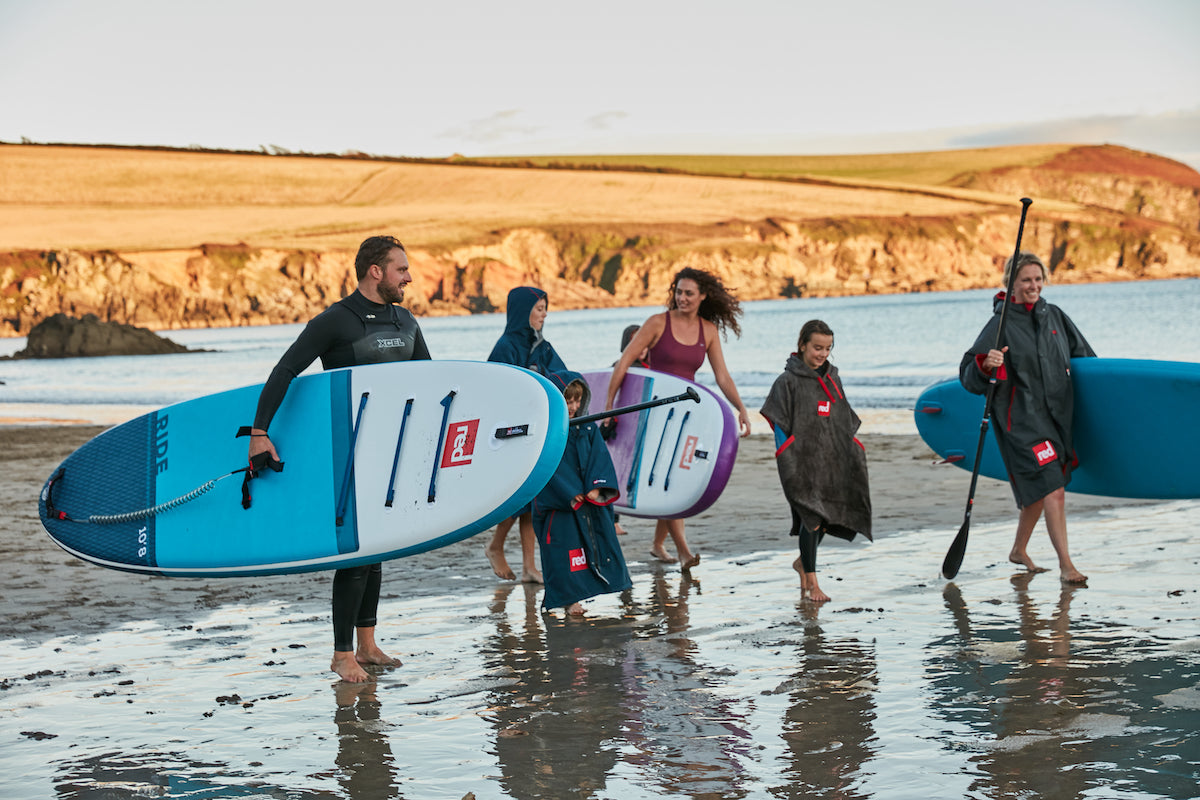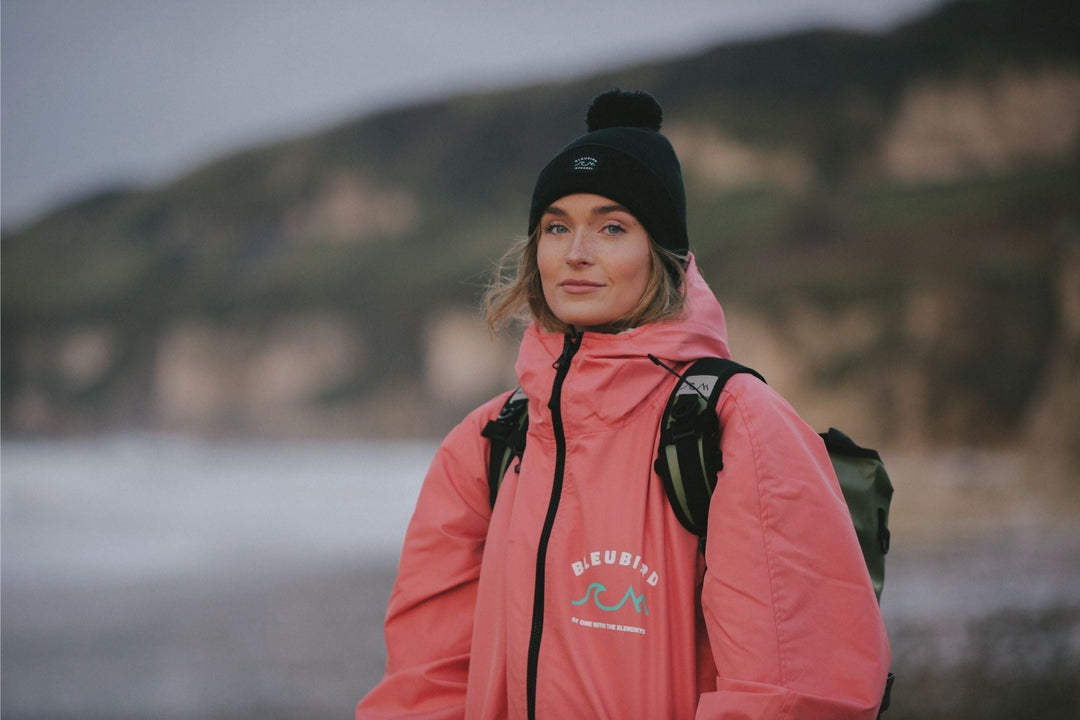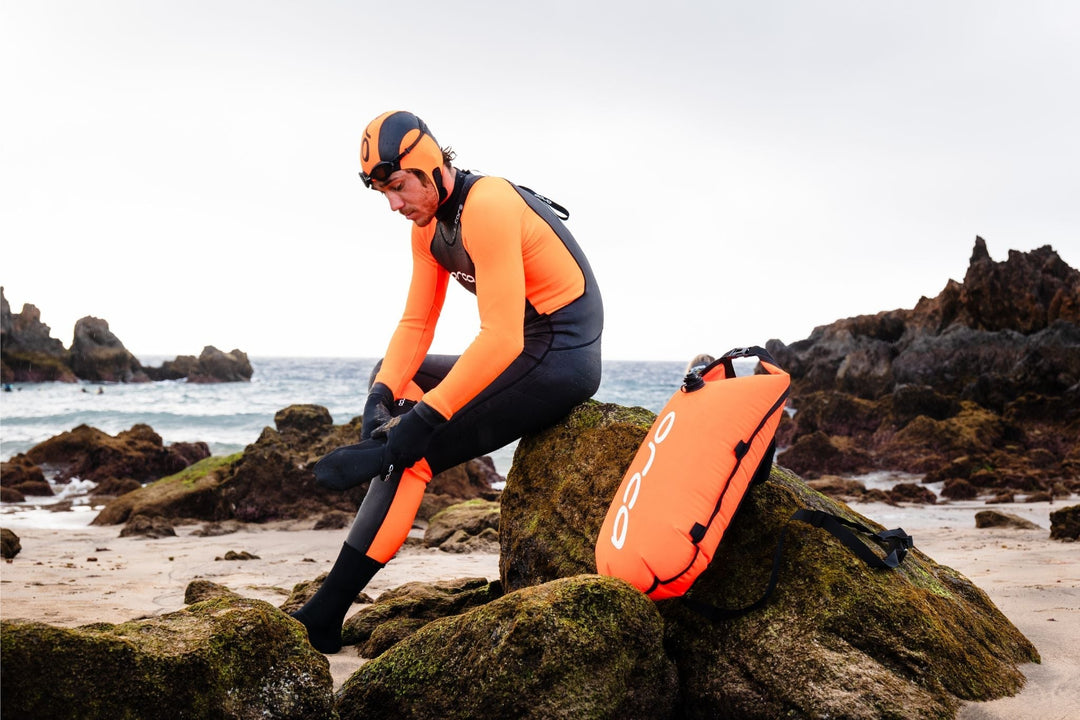Stand up paddle boarding is one of the fastest growing water sports in the world. Whether you want to enjoy a chilled-out paddle, catch waves, practice SUP yoga or enjoy a fun full-body workout, SUP can deliver.
If you want to maximise your enjoyment, you need to ensure that you have the right paddle board and equipment for your needs.
Here’s our short beginners’ guide to buying all the SUP equipment you need to get started, including Inflatable SUP boards, leashes, pumps, clothing and buoyancy aids.
Inflatable vs Solid paddle board: Which type should you choose?
One of the first decisions you need to make when buying a stand up paddle board is whether to opt for an inflatable paddle board or a composite paddle board.
Many beginners feel stuck between the two, unsure of the advantages of each and which they should choose. Let’s start by explaining the differences between the two.
Solid paddle boards
Also known as composite, hard, rigid, epoxy, non-inflatable, traditional or fibreglass paddle boards, these are the more traditional type of SUP paddle board.
Their solid construction means that they sit in the water in such a way as to offer a smoother ride, faster and better performance, and they also make it easier to catch and ride waves particularly when conditions get above waist high. This makes them an excellent choice if you’re looking to buy a SUP board for specific disciplines such as surfing or racing.
They’re also easily optimised for conditions, rider weight and skill level which makes it easier for you to find the right option for your needs. You also won’t need to worry so much about puncturing your SUP or suffering from any air leakage.
However, if you choose a solid stand-up paddle board, you will need to ensure that you have both the space to store the board itself and can transport it easily with a protective roof rack on your car. There is also a greater risk of damaging your board on a rock or hard surface which would need a subsequent repair.
Inflatable Paddle boards
Inflatable SUP paddle boards are made from PVC with a drop-stitch to create an air core. They come with a pump and storage bag and feel rigid when inflated correctly.
Despite how it might appear, they can be exceptionally durable and can withstand blunt impacts with rocks, logs and other similar surfaces. This makes them a great choice for rivers and rocky shorelines as the board will simply bounce off without sustaining too much damage.
Because they’re softer than hard boards, they also offer a safer ride for beginners who haven’t yet developed their skills and might fall or those who need extra comfort to practice SUP yoga.
Of course, they’re an excellent choice if you live in a small flat or you don’t have much storage space. You can simply transport the board in the boot of your car, take it on public transport or even travel abroad with it, then inflate it when you arrive at your destination. They can also be more affordable than solid boards, making them a sensible option if you’re just dipping your toe into the sport.
Having said that, they do have their disadvantages too. For starters, many people would prefer not to spend time inflating and deflating their board before they can head out onto the water. As the board is softer, it can feel wobbly and travel at slower speeds than a solid SUP.
Which size and shape paddle board should you go for?
When deciding on which paddle board to buy, you also need to find the right size and shape for you.
Your choice of paddle board should support you in the water and provide the right level of stability for your skill level, experience, conditions and overall requirements.
This is determined by the volume of your board and its weight capacity. We measure the volume of paddle boards in litres using the board’s length, weight and height. Put simply, the larger the volume of your board, the more weight it can support.
Weight capacity
When choosing your board, it’s a good idea to consider what your weight requirements will be. Ask yourself the following questions:
- How heavy am I?
- How much gear do I want to take with me?
- Will I be travelling alone, or will my pets, kids or other riders be joining me?
- How experienced am I?
The weight of your board and its load will affect how easy it is to control and how user friendly it is.
Length
Surfers or kids should have a shorter board because they’re easier to manoeuvre. Medium boards are ideal for yoga and all-around use. Longer boards are ideal for faster paddling, touring long distances and added stability.
Width
SUP paddle boards tend to measure between 25-36 inches in width. The wider of these are easier to handle and so excellent for beginners, those carrying lots of gear or SUP yoga. If you’re a larger person, they also offer the added stability you need to control your board effectively in the water and improve your skills.
Narrower boards are less stable, but they do offer a faster and more dynamic experience for those with more skill and experience. Smaller, lighter people might also find them to be an excellent choice.
Thickness
SUP paddle board thickness is another important consideration to make when buying a paddle board. A thicker board will have more volume and be able to support more weight, so again consider your weight and overall requirements before making your choice.
Which accessories do you need?
It’s not only about the board itself. You’ll also need a few accessories to go with it to make your SUP experience safer and more fun. The bare minimum you’ll need is a paddle, leash, board bag (for solid SUPs) and a personal flotation device (PFD), although there are many other extras you could benefit from having.
These include:
SUP Paddle
Paddles come in a range of shapes, sizes and materials to suit your skill level, the conditions and your paddle board type. When you buy your first SUP in a package, you’ll find a paddle included in the kit provided so you don’t need to worry too much about the technical side of things. If you want to upgrade, look for a paddle that is 6-10 inches longer than your height. We will in a future blog look at the pros and cons of different paddle constructions.
SUP Leash
This is a very important piece of kit that keeps you connected to your SUP even when you fall off. This consists of a strap that attaches around your ankle and is held in place with Velcro. Again, most boards come with a SUP leash. If choosing a separate leash, look for one around the same size as your board for maximum comfort.
SUP Board Bag
Protect your board and ensure that you can enjoy it for many years to come by investing in a high-quality SUP board bag. Bear in mind that inflatable SUPS usually come with a board bag for easy storage.
SUP Pump
If you’re buying an inflatable SUP, you’ll have a pump included in the kit that is usually a manual, single-cylinder pump. If you want to inflate your board faster and don’t mind the extra weight, look for a dual-action or electric SUP pump instead.
SUP Buoyancy Aid (PFD)
Depending on where you live, you may be obliged to use a personal floatation device with your SUP. It’s also a sensible idea to use a PFD if you are a child, poor swimmer, or heading into white water. Choose from a traditional-style life buoyancy aid or an understated belt pack that can be inflated in case of an emergency.
SUP Dry Bag
As the name suggests, a dry bag can help you keep your valuables dry and safe from harm. Pop your phone, camera, clothes and anything else you want to keep dry inside and then enjoy your ride. Most dry bags come with adjustable straps to allow you to wear the bag across your body and paddle in added comfort.
SUP car accessories
Unless you have an inflatable SUP board, you’ll need to invest in a solid or soft roof rack for your car and tie down straps to keep your board in place. This will also allow you to explore further afield without needing to worry about your board coming to any harm.
Wetsuits and SUP wear
Stay warm and dry whilst you’re paddle boarding by choosing the right clothing. If the weather is cool or there’s a risk you’ll fall into cold water, consider getting yourself a wetsuit. Otherwise, it’s usually best to layer your SUP clothing so that it can be removed as the weather changes.
This could include:
- Neoprene or quick-dry leggings
- Short sleeve wetsuit
- Neoprene, thermal or long or short-sleeved top, preferably with sun protection
- Neoprene jacket, wind stopper jacket, quick-dry jackets or jumper
- Wind stopper trousers
- Neoprene beanie
- 3-5 mm booties
- Neoprene gloves (for cooler temperatures)
Whatever you choose, ensure that you check the local weather conditions before travelling, including the wind chill factor. Avoid wearing jeans, wool and other fabrics that take a long time to dry.
Changing Robe
If you’re travelling to somewhere that doesn’t have facilities, take a changing robe or poncho towel with you. You’ll stay warm, protect your modesty and stay cosy without breaking the bank. A quick dry poncho towel will pack down small in your dry bag or SUP deck bag.
SUP attachment points and mounts
Fancy a spot of SUP fishing? Want to mount your GoPro camera onto your board? Perhaps you’d like to turn your SUP into a kayak? Treat yourself to one of these extras and take your boarding experience to a whole new level of cool.
Conclusion
Follow the tips we’ve shared here, and you can get the SUP equipment you need to start enjoying this incredible, beginner-friendly sport today. We are Dublin’s Premier Watersports Course provider & Surf Shop with over 30 years of experience and are here to help.
If you have any questions, don’t hesitate to pop into our Dublin city-centre shop or email us shop@surfdock.com today.






Leave a comment